BIOT Science Expedition 2014 - Crabs, birds and a profusion of fish - Day 16 & 17
Crabs, birds and a profusion of fish

As we were out in the dark hours pursuing the nocturnal kings of the islands, the impressive coconut crabs, I was nowhere near the internet last night so it is another double up on the blogs today. This overnight effort completed the work we were doing ashore and Pete has a few words on how things have gone.

“Tired and rain-sodden, a craft came to retrieve the overnight shore party as the day broke. We had just completed the final night of surveying for Coconut Crabs. Three very different islands and 75 transect lines later, our nocturnal activities continued to raise more questions than they answered. One island without rats had a fairly even distribution of adults and juveniles; the small rat-infested island had no adults at all and the large rat-infested island had many very large adults, the majority being males.
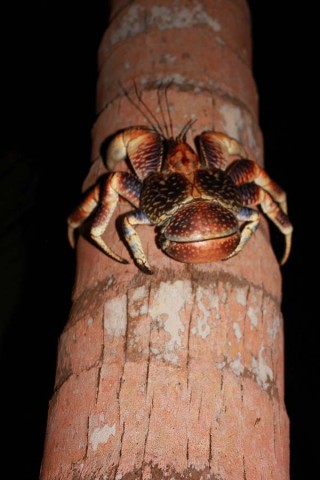
We intend to fully analyse our data and hope to publish a short paper on our findings. So little is known of this IUCN Red-Listed Data Deficient species in the Chagos that all published information is important as it could assist with management plans to protect and conserve it. This is particularly pertinent as its range and numbers are declining globally. Similar to some of the bird species that are thriving in the Chagos, these breeding stocks are of critical importance in the Indian Ocean as they can act as reserves to restock depleted populations elsewhere. It is hoped our Coconut Crab surveys on this expedition will be the catalyst for further studies of this unique gastropod, the largest in its family. Watch this space in 2015 for more information.”
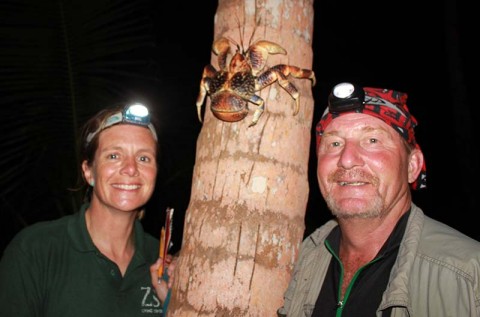
Although night activities on the islands have curtailed sleeping hours a little there has been no let up in the dive programme. So it has been a full couple of days with a busy night in between. The dives during the day have seen us both lagoonside and Oceanside of a couple of islands which have provided a good bit of variation in the environment underwater.
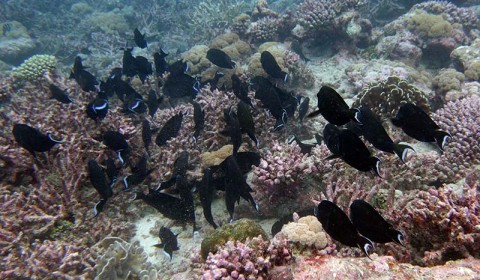
There have been a few areas where there have been large die offs of coral which are showing signs of stabilising and in contrast to this areas very rich in coral diversity and health. Over the reef the fish life has been varied and prolific. Some dives provided a wealth of megafauna, large grouper and sharks gathered eyeing us inquisitively, whilst other dives had a profusion of smaller fish schooling around the outcrops of reef.

An amazing setting for the last two days work, John Turner has penned a few words to share more on his efforts here.
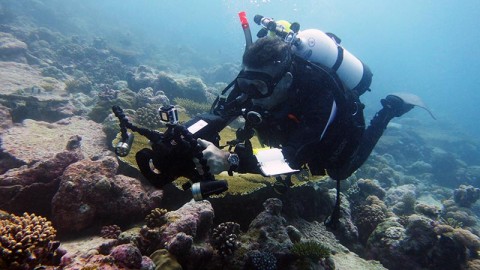
“While undertaking long term monitoring of coral reefs, myself and Ronan Roche are also building up a picture of the larger scale structure at each reef site. Greater structural complexity provided by coral colonies can provide a greater variety of niches for other species, particularly fish which are being assessed by Melita and Heather at the same reef sites. The video archive being recorded by myself provides a high definition close up view of the coral structure at a scale of a few metres , while a small camera mounted on top of the underwater video camera records a wide angle image every 30 seconds at a scale of tens of metres, dependent on underwater visibility. Ronan records notes to describe reef structure at a scale of up to 100m, and also records some close up photographs at a scale of 50cm to 1m to ‘truth’ the video imagery.
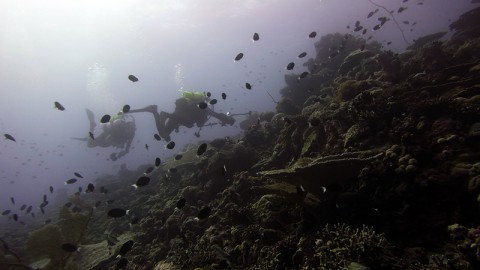
Ronan and I will combine our image data and observations to describe the topography and rugosity (roughness) of each reef, and these results will provide an important factor in understanding the structure of fish communities.”
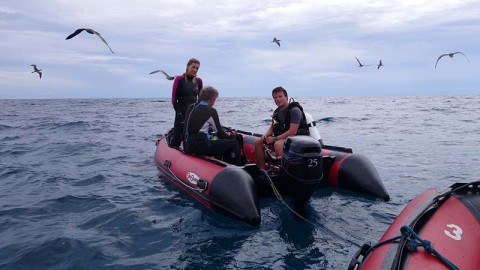
The dive and work programme has been very busy on this trip and left little time for reflection. There are moments of quiet though when we can just enjoy the richness of the environment and wildlife here. Surfacing from the dive today to find the sky around the dive boats teeming with curious seabirds from the nearby rat free island was such an opportunity. Whilst we sat on safety for the following dive team as they drifted beneath the waves we had the company of energetic boobies and terns as they breezed about on the gentle wind. In our discussions now realization is dawning amongst our group that we are almost at the end of our time here. Better make the most of it and keep busy. There will be time for reflection when we are home, for the moment soak up and discover as much of the great environment of this remote territory as is possible.


